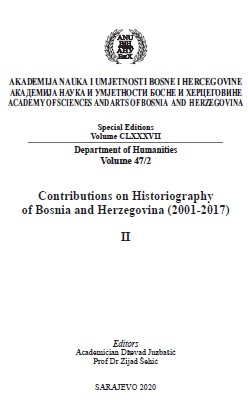Historiografija i historijski izvori o genocidu u Srebrenici
Historiography and historical sources on genocide in Srebrenica
Author(s): Merisa Karović-Babić
Subject(s): Criminal Law, International Law, Law and Transitional Justice, Military history, Studies in violence and power, Nationalism Studies, Transformation Period (1990 - 2010), Peace and Conflict Studies
Published by: Akademija Nauka i Umjetnosti Bosne i Hercegovine
Keywords: Srebrenica; verdicts; genocide; victims; responsibility; Army and police of the Republic of Srpska; State Security Service of the Republic of Serbia; Directive no. 7; Dutch Battalion (HOBLAT);
Summary/Abstract: There are numerous papers dealing with research of genocide in Srebrenica, as well as papers dealing with denial of it. An insight into a number of publications related to these topics raises the question of whether quantity prevails over quality and how much research on genocide in Srebrenica is based on scientific methods and how much on the arbitrary interpretation of historical events. This paper presents an overview of a large number of published works, with particular emphasis on a more detailed analysis of the work of historians as well as published historical sources. Many trials before national and international courts have been conducted against individuals charged with crimes against humanity and international law, including the crime of genocide committed in and around Srebrenica from 10-19. July 1995. Detailed descriptions of mass executions, with data on the number of victims, forensic evidence, mass graves of primary, secondary and tertiary character, can be found in the verdicts rendered in the abovementioned court processes. The significance of these judgments for the historiography of the Srebrenica genocide is immeasurable. They represent an important historical source and a starting point for any further research. The documents in the possession of the ICTY, which were used in the above processes, are available in the Tribunal’s electronic database and are also very significant for historical science. The verdicts gave a detailed reconstruction of the “nine days of hell,” as judges characterized the period after the fall of Srebrenica. The question of representation of earlier periods in historiography, relating to very dynamic developments within Srebrenica during 1992, 1993 and 1994, is also discussed in the paper. Public discourse on the Srebrenica genocide is completely dominated by topics from July 1995, which gives the impression that the period preceding the fall of the enclave is neglected.
Book: Prilozi o historiografiji Bosne i Hercegovine (2001–2017) II
- Page Range: 21-68
- Page Count: 48
- Publication Year: 2020
- Language: Bosnian, Croatian, Serbian
- Content File-PDF

